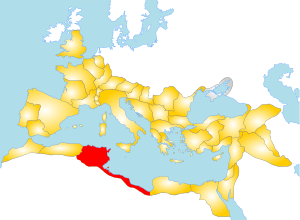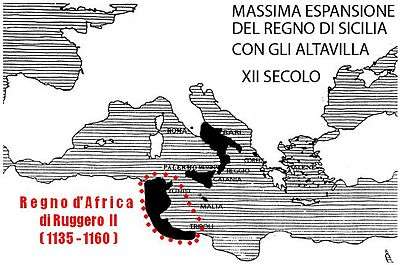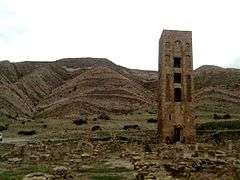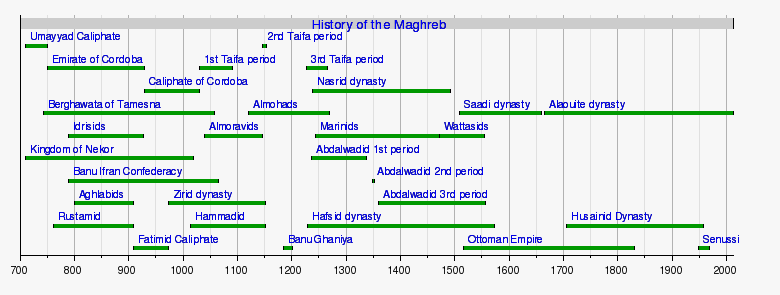Ifriqiya

Part of a series on the |
||||||||||||
|---|---|---|---|---|---|---|---|---|---|---|---|---|
| History of Tunisia | ||||||||||||
 | ||||||||||||
|
Prehistoric |
||||||||||||
|
|
||||||||||||
|
||||||||||||
|
| ||||||||||||
Ifriqiya or Ifriqiyah (Arabic: إفريقية Ifrīqya) or el-Maghrib el-Adna (Lower West) was the area during medieval history that comprises what is today Tunisia, Tripolitania (western Libya) and the Constantinois (eastern Algeria); all part of what was previously included in the Africa Province of the Roman Empire.[1]
The southern boundary of Ifriqiya was far more unchallenged as bounded by the semi-arid areas and the salt marshes called el-Djerid. The northern and western boundaries fluctuated; at times as far north as Sicily otherwise just along the coastline, and the western boundary usually went as far as Béjaïa. The capital was briefly Carthage, then Qayrawan (Kairouan), then Mahdia, then Tunis.[2] The Arabs generally settled on the lower ground while the native population settled in the mountains.
The Aghlabids, from their base in Kairouan, initiated the invasion of Sicily beginning in 827 and establishing the Emirate of Sicily, which lasted until it was conquered by the Normans.
History
Conquest phase
- (Cyrenaica and Tripolitana conquered in 643 by Amr ibn al-As, organized as new province with regional capital at Barqa; first governors uncertain.)[3]
- Mu'awiya ibn Hudaij al-Kindi, c.665–666 — ruled from Barqa[4]
- Oqba ibn Nafi'i al-Fihri, 666–674 — conquered south Tunisia (Byzacena), founded Kairouan (670)
- Abu al-Muhajir Dinar, 674–681
- Oqba ibn Nafi'i al-Fihri, (restored), 681–683 — led cavalcade to Morocco, ostensibly bringing entire Maghreb under submission.
- (Oqba killed. Arabs expelled from Byzacena, occupied by Awraba Berber chieftain Kusaila, 683–686)
- Zuhair ibn Qais al-Balawi, 683–689 — initially only Barqa, recovered Byzacena in 686.
- (Zohair killed. Berbers under Kahina recover Byzacena in 689. No clear Arab governor, 689–92).
- Hassan ibn al-Nu'man al-Ghassani, 692–703 — initially only Barqa. Captured Carthage in 695 (lost again), then again in 698 (final). Permanent conquest of Ifriqiya, organized as new province, separately from Egypt, directly under Umayyad Caliph, with capital at Kairouan.
Umayyad Governors of Ifriqiya
- Musa ibn Nusair al-Lakhmi, 703–715
- (During conquest of Spain, Abd Allah ibn Musa was regent in Kairouan, while Musa was in al-Andalus, 712–715)
- Muhammad ibn Yazid, 715–718
- Ismail ibn Abd Allah ibn Abi al-Muhajir, 718–720
- Yazid ibn Abi Muslim, 720–721
- Muhammad ibn Yazid (restored), 721
- Bishr ibn Safwan al-Kalbi, 721–727
- Obeida ibn Abd al-Rahman es-Solemi, 727–32
- Oqba ibn Qudama (temporary), 732–734
- Obeid Allah ibn al-Habhab al-Maousili, 734–41. (Berber Revolt begins 740)
- Kulthum ibn Iyad al-Qasi, 741
- Balj ibn Bishr al-Qushayri (de jure, in Córdoba) and Abd al-Rahman ibn Oqba al-Ghaffari (de facto, in Kairouan), 741–42
- Handhala ibn Safwan al-Kalbi, 742–44
Fihrid Emirs of Ifriqiya
- (Independence from Caliphate: Berber statelets in Morocco; Fihrid coup d'état in Kairouan, 745)
- Abd al-Rahman ibn Habib al-Fihri, 745–755.
- Ilyas ibn Habib al-Fihri, 755
- Habib ibn Abd al-Rahman al-Fihri, 755–57
Kharijite rulers
- (Fihrid Ifriqiya conquered by Kharijite Berbers in 757 — Sufrite Warfajuma in Kairouan, Ibadite Nafusa in Tripoli)
- Asim ibn Jamil al-Warfajumi (Sufrite), 757–758
- Abd al-Malik ibn Abi 'l-Jad al-Waranjumi (Sufrite), 758
- (Ibadites of Tripoli depose Sufrites in Kairouan, 758)
- Abu al-Khattab Abd al-Ala ibn al-Samh al-Maafiri (Ibadite), 758–760
- Abd al-Rahman ibn Rustem al-Farissi (Ibadite), 760–62
Abbasid governors in Kairouan
- Appointed governors
- Muhammad ibn al-Ash'ath al-Khuza'i 762–765 (former Abbasid governor of Egypt)
- Isa ibn Yussuf al-Khurasani 765
- al-Aghlab ibn Salim at-Tamimi 765–766
- al-Hassan ibn Harb al-Kindi 766–767
- al-Mikhariq ibn Ghuffar 767–768
- Umar ibn Hafs al-Muhallabi 768–771
- Habib ibn Habib al-Muhallabi 771
- Umar ibn Hafs al-Muhallabi 771
- Abu Hatim Yaqub ibn Labib al-Khariji 771–772 (Ibadi rebel)
- Yazid ibn Hatim al-Muhallabi 772–787
- Dawud ibn Yazid ibn Hatim al-Muhallabi 787
- Rawh ibn Hatim al-Muhallabi 787–791
- Nasr ibn Habib al-Muhallabi 791–793
- al-Fadl ibn Rawh ibn Hatim al-Muhallabi 793–795
- Appointed governors
- Harthama ibn Ayan 795–797
- Muhammad ibn Muqatil al-Akki, 797–799
- Tammam ibn Tamim al-Tamimi 799–800
- Muhammad ibn Muqatil al-Akki 800
Aghlabid Emirs of Ifriqiya
- Ibrahim I ibn al-Aghlab ibn Salim (800–812)
- Abdallah I ibn Ibrahim (812–817)
- Ziyadat Allah I ibn Ibrahim(817–838)
- al-Aghlab Abu Iqal ibn Ibrahim (838–841)
- Abu 'l-Abbas Muhammad I ibn al-Aghlab Abi Affan (841–856)
- Ahmad ibn Muhammad (856–863)
- Ziyadat Allah II ibn Abil-Abbas (863)
- Abu 'l-Gharaniq Muhammad II ibn Ahmad (863–875)
- Abu Ishaq Ibrahim II ibn Ahmad (875–902)
- Abu 'l-Abbas Abdallah II ibn Ibrahim (902–903)
- Abu Mudhar Ziyadat Allah III ibn Abdallah (903–909)
Fatimid Caliphs in Ifriqiya
- Abū Muḥammad ʻAbdu l-Lāh (ʻUbaydu l-Lāh) al-Mahdī bi'llāh (909–934) — founder of the Fatimid dynasty
- Abū l-Qāsim Muḥammad al-Qā'im bi-Amr Allāh (934–946)
- Abū Ṭāhir Ismā'il al-Manṣūr bi-llāh (946–953)
- Abū Tamīm Ma'add al-Mu'izz li-Dīn Allāh (953–975) (transferred to Egypt in 973)
Zirid dynasty rulers of Ifriqiya
- Abul-Futuh Sayf ad-Dawla Buluggin ibn Ziri (973–983)
- Abul-Fat'h al-Mansur ibn Buluggin (983–995)
- Abu Qatada Nasir ad-Dawla Badis ibn Mansur (995–1016)
- Sharaf ad-Dawla al-Muizz ibn Badis (1016–1062), — lost west Ifriqiya to Hammadid dynasty,(1018), declared independence from Fatimids (1045)
(invasion of the Banu Hilal (1057) — Kairouan destroyed, Zirids reduced to the main coastal cities, rural areas fragments into petty Bedouin emirates)[8]
- Abu Tahir Tamim ibn al-Mu'izz (1062–1108)
- Yahya ibn Tamim (1108–1131)
- Ali ibn Yahya (1115–1121)
- Abul-Hasan al-Hasan ibn Ali (1121–1152)
(Ifriqiyan coast annexed by Norman Sicily (1143–1160))
Norman kings of the Kingdom of Africa (Ifriqiya)

- Roger II of Sicily (1143-1154)
- William I of Sicily (1154-1160)
(All of Ifriqiya conquered and annexed by the Almohads (1160))[10]
Hafsid governors of Ifriqiya
- Abd al-Wahid (1207–1216)
- Abd-Allah (1224–1229)
- Abu Zakariya (1229–1249)
Hafsid caliphs of Ifriqiya
- Muhammad I al-Mustansir (1249–1277)
- Muse Mohammed {1223–1270}
- Yahya II al-Watiq (1277–1279)
- Ibrahim I (1279–1283)
- Ibn Abi Umara (1283–1284)
- Abu Hafs Umar I (1284–1295)
- Muhammad I (1295–1309)
- Abu Bakr I (1309)
- Aba al-Baqa Khalid an-Nasir (1309–1311)
- Aba Yahya Zakariya al-Lihyani (1311–1317)
- Muhammad II (1317–1318)
- Abu Bakr II (1318–1346)
- Abu Hafs Umar II (1346–1349)
- Ahmad I (1349)
- Ishaq II (1350–1369)
- Abu al-Baqa Khalid (1369–1371)
- Ahmad II (1371–1394)
- Abd al-Aziz II (1394–1434)
- Muhammad III (1434–1436)
- Uthman (1436–1488)
- Abu Zakariya Yahya (1488–1489)
- Abd al-Mu'min (Hafsid) (1489–1490)
- Abu Yahya Zakariya (1490–1494)
- Muhammad IV (1494–1526)
- Muhammad V (1526–1543)
- Ahmad III (1543–1570)
- Muhammad VI (1574–1574)
- Jafari "Jafari the Clean" Yahya (1574–1581)
- Alem Nafirr (1581)
See also
Notes
- ↑ (in French) Article « Ifriqiya » (Larousse.fr).
- ↑ http://en.wikisource.org/wiki/Arabic_Thought_and_Its_Place_in_History : DE LACY O’LEARY, D.D. "ARABIC THOUGHT AND ITS PLACE IN HISTORY" London: KEGAN PAUL, TRENCH, TRUBNER & CO., LTD. / NEW YORK: E. P. DUTTON & CO. (1922), pp. 227-8.
- ↑ See chronicles of Ibn Abd al-Hakam and al-Nuwayri for accounts of the conquest.
- ↑ This follows the tradition of al-Nuwayri, who says Mu'waiya ibn Hudaij was the first emir of Ifriqiya (ruling from Baqra) in 665. Ibn Khaldoun, however, dates the appointment of Mu'waiya ibn Hudaij as early as 651/52, when Abdallah ibn Sa'ad was governor in Egypt.
- ↑ This is primarily covered in the chronicle of al-Nuwayri.
- ↑ On the rise of the Fatimids, see Ibn Khaldoun (v.2 App. #2(pp.496–549))
- ↑ See al-Nuwayri (v.2, App.1) and Ibn Khaldoun, v.2
- ↑ On the Banu Hillal invasion, see Ibn Khaldoun (v.1).
- ↑ Abulafia, "The Norman Kingdom of Africa"
- ↑ For an account of the Almohad and Norman conquests of Ifriqiya, see Ibn al-Athir (p.578ff)
- ↑ See Ibn Khaldoun (v.2 & 3)
Sources
Chronicles
- Ibn Abd al-Hakam, English trans. by C.C. Torrey, 1901, "The Mohammedan Conquest of Egypt and North Africa", Historical and Critical Contributions to Biblical Science, pp. 277–330. online; French trans. in De la Salle Histoire des Berbères et des dynasties musulmanes de l'Afrique Septentrionale, 1852, v.1, App. 1 (pp. 301–308)
- al-Nuwayri, French trans. in De La Salle, Histoire des Berbères et des dynasties musulmanes de l'Afrique Septentrionale, 1852, v.1, App. 2 (pp. 314–444) (From 647 raid through end of Aghlabids) and 1854, v. 2 App.1 (pp. 483–89) (for Zirids). Italian transl. in M. Amari (1851) Nuova raccolta di scritture e documenti intorno alla dominazione degli arabi in Sicilia, (p.27-163) (Aghlabids only)
- Ibn Khaldoun, French trans. in De La Salle (1852–56), Histoire des Berbères et des dynasties musulmanes de l'Afrique Septentrionale 4 vols, Algiers: Imprimerie du Gouvernment. v.1, v.2 v.3, vol. 4
- Ibn al-Athir extracts from Kamel al-Tewarikh, French trans. in De La Salle, Histoire des Berbères et des dynasties musulmanes de l'Afrique Septentrionale, 1854, v.2, App.#5, (pp. 573ff)
Secondary
- Julien, C.A. (1931) Histoire de l'Afrique du Nord, vol. 2 – De la conquête arabe à 1830, 1961 edition, Paris: Payot.

